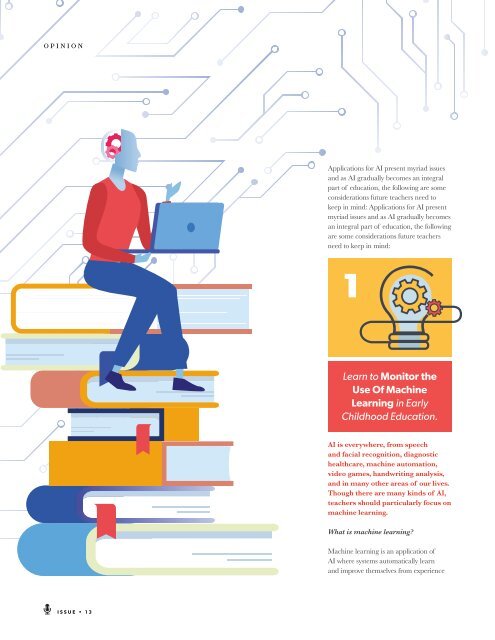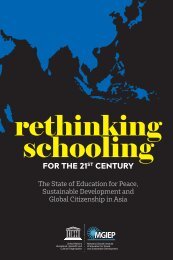The Blue DOT Issue 13
Reimagining Education: Beyond the Rhetoric
Reimagining Education: Beyond the Rhetoric
You also want an ePaper? Increase the reach of your titles
YUMPU automatically turns print PDFs into web optimized ePapers that Google loves.
Applications for AI present myriad issues<br />
and as AI gradually becomes an integral<br />
part of education, the following are some<br />
considerations future teachers need to<br />
keep in mind: Applications for AI present<br />
myriad issues and as AI gradually becomes<br />
an integral part of education, the following<br />
are some considerations future teachers<br />
need to keep in mind:<br />
1<br />
Learn to Monitor the<br />
Use Of Machine<br />
Learning in Early<br />
Childhood Education.<br />
AI is everywhere, from speech<br />
and facial recognition, diagnostic<br />
healthcare, machine automation,<br />
video games, handwriting analysis,<br />
and in many other areas of our lives.<br />
Though there are many kinds of AI,<br />
teachers should particularly focus on<br />
machine learning.<br />
What is machine learning?<br />
Machine learning is an application of<br />
AI where systems automatically learn<br />
and improve themselves from experience<br />
without needing additional programming.<br />
You give the machine data, and the system<br />
uses that data to learn.<br />
How can machine learning be applied<br />
in early childhood education?<br />
Let’s consider a possible application of this<br />
in early childhood education, which we will<br />
call the iTeddy, an intelligent teddy bear<br />
that builds a profile of the child to provide<br />
personalized education, implementing AI<br />
based on developmentally appropriate<br />
practice (DAP). <strong>The</strong> National Association<br />
for the Education of Young Children<br />
(NAEYC)’s position statement on DAP<br />
states that “every child, from birth to<br />
8, has the right to equitable learning<br />
opportunities—in centers, family<br />
child care homes, or schools—<br />
that fully support their optimal<br />
development and learning across all<br />
domains and content areas.” One of<br />
the core considerations of DAP is that<br />
learning experiences should be unique to<br />
each child. Educators need to spend time<br />
getting to know the child, understanding<br />
their family and community, observing<br />
them, examining their work, and using<br />
authentic, valid, and reliable assessment<br />
methods to know their interests, strengths,<br />
personalities, and motivations.<br />
This consideration is also in line with Lev<br />
Vygotsky’s Zone of Proximal Development<br />
theory: finding the “sweet spot” where<br />
learning experiences are challenging but<br />
achievable. Some believe that something<br />
like an iTeddy could help meet this<br />
standard, by monitoring the child and<br />
providing 1-to-1 tutoring based on the<br />
child’s needs. Imagine if iTeddy observed<br />
the child over a period of time and<br />
found that he or she has a keen interest<br />
in math and only a moderate interest<br />
in art. Recognizing this “sweet spot,”<br />
iTeddy’s AI provides the child with more<br />
and more math activities, while limiting<br />
the art-related ones. In one sense, iTeddy<br />
would allow better scaffolding for the<br />
child, exposing ideas at a personalized<br />
pace and implementing a developmentally<br />
appropriate math curriculum to ensure the<br />
child is engaged and challenged.<br />
<strong>The</strong> concern, however, is that the iTeddy<br />
might make an incorrect assumption about<br />
the psychological profile of the child by<br />
comparing the hundreds of thousands<br />
of other children with a similar age,<br />
developmental stage, and profile. It may<br />
also underestimate how humans and their<br />
interests change over time, potentially<br />
depriving the child of art-related activities<br />
in favor of an increase in math activities.<br />
This problem is not unique to AI<br />
applications, however, as students often<br />
get left behind in current learning settings.<br />
<strong>The</strong>ir talents and interests may not be<br />
properly assessed by parents or teachers<br />
or a hesitance to try something new may<br />
prevent the child from blossoming in a<br />
certain area. <strong>The</strong> question remains, would<br />
an AI application like iTeddy open more<br />
possibilities for children or limit them?<br />
<strong>The</strong> iTeddy is just one example of teachers<br />
needing to prepare themselves for various<br />
applications of AI within education.<br />
Teachers will need to become<br />
data scientists; able to understand<br />
assessment data generated by AI<br />
and monitor its decisions. More than<br />
ever, teachers will need to be ready<br />
to comment on the developmentally<br />
appropriate use of AI applications.<br />
Teachers will need to<br />
become data scientists;<br />
able to understand<br />
assessment data generated<br />
by AI and monitor its<br />
decisions. More than<br />
ever, teachers will need<br />
to be ready to comment<br />
on the developmentally<br />
appropriate use of AI<br />
applications.<br />
2<br />
Act as Advisors to<br />
Programmers.<br />
Though difficult to believe, computer<br />
scientists developing AI may very<br />
well consult teachers and other child<br />
development experts for their knowledge<br />
and advice. This is because children’s<br />
development is a crucial part of artificial<br />
intelligence. In 1950, Alan Turing said,<br />
“Instead of trying to produce a program<br />
to simulate the adult mind, why not rather<br />
try to produce one which simulates the<br />
child’s.” Turing believed that the key to<br />
true artificial intelligence would be to<br />
design a machine with the ability to learn<br />
like a human child. Far from the “tabula<br />
rasa” traditions, children are a blank slate,<br />
the complexity of a baby’s brain and its<br />
ability to innately know and to learn still<br />
shocks and awes most neuroscientists.<br />
Roboticists and computer scientists<br />
are trying to figure out how to design<br />
a machine that has similar learning<br />
abilities, but we are still far from<br />
such a development. As the pursuit<br />
of machine learning continues,<br />
computer scientists will undoubtedly<br />
turn to experts in the learning<br />
process of a child’s incredible mind.<br />
In this case, the experts are the<br />
educators.<br />
OPINION<br />
ISSUE • <strong>13</strong><br />
1 7

















